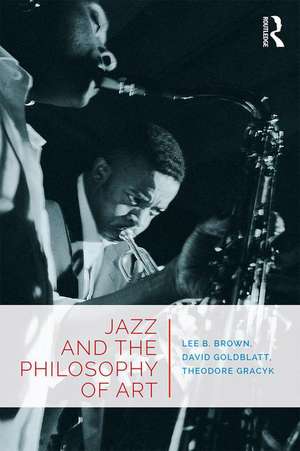Jazz and the Philosophy of Art
Autor Lee B. Brown, David Goldblatt, Theodore Gracyken Limba Engleză Paperback – 12 feb 2018
musical forgeries, and jazz singing, as well as Goodman’s allographic/autographic distinction, Adorno’s critique of popular music, and what improvisation is and is not.
The book is organized into three parts. Drawing on innovative strategies adopted to address challenges that arise for the project of defining art, Part I shows how historical definitions of art provide a blueprint for a historical definition of jazz. Part II extends the book’s commitment to social-historical contextualism by exploring distinctive ways that jazz has shaped, and been shaped by, American culture. It uses the lens of jazz vocals to provide perspective on racial issues previously unaddressed in the work. It then examines the broader premise that jazz was a socially progressive force in American popular culture. Part III concentrates on a topic that has entered into the arguments of each of the previous chapters: what is jazz improvisation? It outlines a pluralistic framework in which distinctive performance intentions distinguish distinctive kinds of jazz improvisation.
This book is a comprehensive and valuable resource for any reader interested in the intersections between jazz and philosophy.
| Toate formatele și edițiile | Preț | Express |
|---|---|---|
| Paperback (1) | 367.49 lei 6-8 săpt. | |
| Taylor & Francis – 12 feb 2018 | 367.49 lei 6-8 săpt. | |
| Hardback (1) | 1004.20 lei 6-8 săpt. | |
| Taylor & Francis – 7 feb 2018 | 1004.20 lei 6-8 săpt. |
Preț: 367.49 lei
Nou
Puncte Express: 551
Preț estimativ în valută:
70.34€ • 75.92$ • 58.98£
70.34€ • 75.92$ • 58.98£
Carte tipărită la comandă
Livrare economică 19 aprilie-03 mai
Preluare comenzi: 021 569.72.76
Specificații
ISBN-13: 9781138241367
ISBN-10: 1138241369
Pagini: 316
Dimensiuni: 152 x 229 x 22 mm
Greutate: 0.4 kg
Ediția:1
Editura: Taylor & Francis
Colecția Routledge
Locul publicării:Oxford, United Kingdom
ISBN-10: 1138241369
Pagini: 316
Dimensiuni: 152 x 229 x 22 mm
Greutate: 0.4 kg
Ediția:1
Editura: Taylor & Francis
Colecția Routledge
Locul publicării:Oxford, United Kingdom
Cuprins
Foreword - Lee Brown: A Recollection
Acknowledgements
Introduction
PART I How is Jazz Distinctive? Essence and Definition
1 Dancing, Dwelling, and Rhythmic Swing
2 A Theory of Jazz Music: "It Don't Mean a Thing ..."
3 Defining Jazz Historically
PART II Jazz and American Culture
4 Jazz Singing and Taking Wing
5 Race, Jazz, and Popular Music: The Legacy of Blackface Minstrelsy
6 Jazz and the Culture Industry
PART III Music Ontology
7 Improvisations and Spontaneity
8 Musical Forgeries, Improvisation, and the Principle of Continuity
9 Phonography, Repetition, and Spontaneity
10 Jazz Improvisation and its Vicissitudes: A Plea for Imperfection
Index
Acknowledgements
Introduction
PART I How is Jazz Distinctive? Essence and Definition
1 Dancing, Dwelling, and Rhythmic Swing
2 A Theory of Jazz Music: "It Don't Mean a Thing ..."
3 Defining Jazz Historically
PART II Jazz and American Culture
4 Jazz Singing and Taking Wing
5 Race, Jazz, and Popular Music: The Legacy of Blackface Minstrelsy
6 Jazz and the Culture Industry
PART III Music Ontology
7 Improvisations and Spontaneity
8 Musical Forgeries, Improvisation, and the Principle of Continuity
9 Phonography, Repetition, and Spontaneity
10 Jazz Improvisation and its Vicissitudes: A Plea for Imperfection
Index
Recenzii
"It would be a treat just to have Lee Brown’s philosophical writings on jazz collected in one volume, but David Goldblatt and Ted Gracyk have gone one step further, transforming these essays into a continuous argument by uniting them with Brown’s unpublished work and extensively revising and updating them. The result is an essentially historical collaborative creation that stands as a nice metaphor for the view of jazz these authors defend."
--Andrew Kania, Trinity University, San Antonio, Texas
"Counteracting the regrettable tendency in anglophone aesthetics to treat jazz as an afterthought, this book devotes sustained attention to jazz in its evolving sociohistorical context. Brown, Goldblatt, and Gracyk defend a pluralistic account of jazz and the aesthetic intentions that shape it, stressing the music’s diversity and its complicated embeddedness in American racial politics. This book is a must-read not only for those concerned with musical aesthetics, but for anyone interested in the powerful contribution that jazz has made and continues to make in American life."
--Kathleen M. Higgins, University of Texas at Austin
"Jazz now is much like film a generation or two ago: it is beginning to receive the serious and sustained attention that it warrants in the world of philosophical aesthetics. This fascinating volume, by a trio of writers all of whom have what jazz players call "big ears", inventively and insightfully explores questions of the definition of this art form, its special and surprisingly unobvious relation to dance and what the authors call the architecture of jazz, the nature of scat singing, what improvisation is – and equally interesting, what it is not, the significance of the non-repeatability of an improvised solo, the role of phonography and recording in spontaneous art, formalist versus historical and social-political interpretations of jazz, and what is involved in learning an improvisational "language". Selected earlier writers – Hodeir, Schuller, Adorno, Goodman -- are enlighteningly re-examined, and the discussion is rich with well-chosen examples from the jazz masters. We see here why the identification and the subtle transgression of stylistic limits matter so much in this music, and we come to understand how unexpected rewards can be found when skilled players take risks. A masterful investigation into a complex, intricate, and easily-misunderstood art."
--Garry L. Hagberg, Bard College
--Andrew Kania, Trinity University, San Antonio, Texas
"Counteracting the regrettable tendency in anglophone aesthetics to treat jazz as an afterthought, this book devotes sustained attention to jazz in its evolving sociohistorical context. Brown, Goldblatt, and Gracyk defend a pluralistic account of jazz and the aesthetic intentions that shape it, stressing the music’s diversity and its complicated embeddedness in American racial politics. This book is a must-read not only for those concerned with musical aesthetics, but for anyone interested in the powerful contribution that jazz has made and continues to make in American life."
--Kathleen M. Higgins, University of Texas at Austin
"Jazz now is much like film a generation or two ago: it is beginning to receive the serious and sustained attention that it warrants in the world of philosophical aesthetics. This fascinating volume, by a trio of writers all of whom have what jazz players call "big ears", inventively and insightfully explores questions of the definition of this art form, its special and surprisingly unobvious relation to dance and what the authors call the architecture of jazz, the nature of scat singing, what improvisation is – and equally interesting, what it is not, the significance of the non-repeatability of an improvised solo, the role of phonography and recording in spontaneous art, formalist versus historical and social-political interpretations of jazz, and what is involved in learning an improvisational "language". Selected earlier writers – Hodeir, Schuller, Adorno, Goodman -- are enlighteningly re-examined, and the discussion is rich with well-chosen examples from the jazz masters. We see here why the identification and the subtle transgression of stylistic limits matter so much in this music, and we come to understand how unexpected rewards can be found when skilled players take risks. A masterful investigation into a complex, intricate, and easily-misunderstood art."
--Garry L. Hagberg, Bard College
Descriere
Co-authored by three prominent philosophers of art, Jazz and Philosophy of Art is the first book in English to be exclusively devoted to philosophical issues in jazz.




















